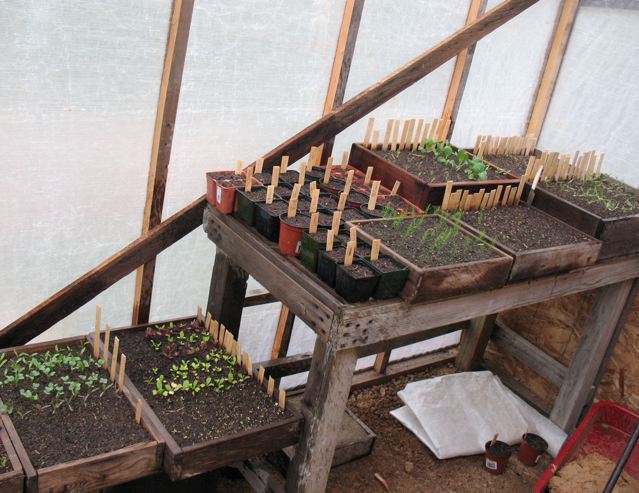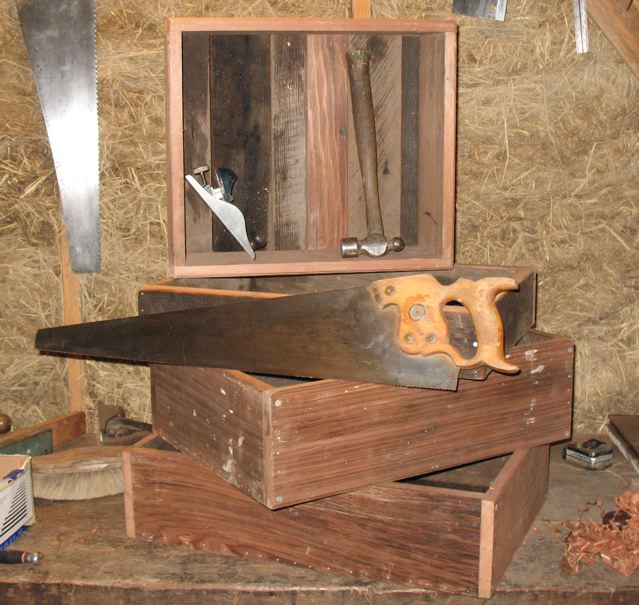 Just finished up planting the main seed starts for the coming season. It's a good feeling to have them up and going as they are the basis of a good garden. Buying starts is expensive, you can't be picky about the varieties you get and they are nice sometimes, but quality varies and other times they just suck. I like to start leeks in January, but most everything else I just start up in the middle of February. I almost never actually start leeks in January and often end up starting them with everything else about now. In February, I seed in flats or pots the tomatoes, eggplant, peppers, turnips, beets, lettuce, mustard greens, chard, pac choi, basil, parsley, kohlrabi, tomatillos, kale, new zealand spinach.... I'm probably forgeting something. Memory is only goes so far, but I'm not inclined to leave the comfort of my bed just yet this morning to go check. I don't grow a lot of cole crops (cabbage, broccoli, cauliflower etc) for various reasons, but I'm sure there are a few that should be started now if not earlier.
Just finished up planting the main seed starts for the coming season. It's a good feeling to have them up and going as they are the basis of a good garden. Buying starts is expensive, you can't be picky about the varieties you get and they are nice sometimes, but quality varies and other times they just suck. I like to start leeks in January, but most everything else I just start up in the middle of February. I almost never actually start leeks in January and often end up starting them with everything else about now. In February, I seed in flats or pots the tomatoes, eggplant, peppers, turnips, beets, lettuce, mustard greens, chard, pac choi, basil, parsley, kohlrabi, tomatillos, kale, new zealand spinach.... I'm probably forgeting something. Memory is only goes so far, but I'm not inclined to leave the comfort of my bed just yet this morning to go check. I don't grow a lot of cole crops (cabbage, broccoli, cauliflower etc) for various reasons, but I'm sure there are a few that should be started now if not earlier.
I don't start the squash and cukes and green beans in flats until about mid march. They grow faster and I don't want them to get pot bound and overgrown. Winter squash I may start even later. I tend to want it to ripen late so it will keep longer through the winter. I sometimes even direct seed it in about mid april.
I've always made my own mix. One year I didn't have it together and bought some "seed starting mix". It turned out to be just sand and peat moss which is kind of lame and provides no nutrients for the plants. If you are going to have to start them in that and then transplant into mix to get them to grow why not just start them in somethig with nutrients in the first place? Potting mix can be used, but it's a poor substitute for a good flat mix.
I sort of follow the biointensive method. Start with 50/50 garden soil and finely sifted compost (I use 1/4 inch screen) The soil, especially for the first time, should be nice soil with structure and some organic matter. Garden soil dug right out of the beds is best. By compost I mean well matured compost made at home with a diversity of materials, not the weak half decomposed industrial stuff you can buy. After this, the extra flat soil is always recycled. I put it into a covered container as I empty the flats through the season. Don't let it sit out in the rain. To each 2 parts of recycled flat mix add 1 part of compost and mix up. I also tend to add a few handfuls of coffee grounds and a small handful of oystershell to each 3 buckets of materials. A mix like this is rich and gives off nutrients over a long period. It will kick butt on any commercial potting mix and grow healthy vigorous starts without any extra fertilizing.
The first year I moved out here I had no compost and didn't want to buy anything. I made flat mix out of whatever was around. I found an old pot growing site in the woods where, typically, all the pipes, cages, pots, and trash were left behind years ago by some greedy slovenly scum bag. Anyway, I used a lot of that stuff and there was some fertilizers and a block of peat moss. I didn't know what the fertilizers were (obviously organic though) probably seaweed and bat guano. I threw in a bit of them, some wood ash, some of the peat, soil collected from gopher and mole hills (another good soil source in the garden). I don't remember what else I put in there, but probably some nitrogen stuff.. coffee grounds or steer manure.... I also used about 50% leaf mould. The leaf mould is gathered in the forest where the leaves pile up. Sometimes on the uphill side of a log the leaves pile up deeper, so there is more leaf mould under the dead leaves. Tanoak and Madrone seem to produce a lot. I do sort of avoid a lot of pine or fir needles. Lot's of people say Tanoak leaves are bad for compost and keep stuff from growing. That's not true. I don't even think they inhibit the growth of other plants at all except by shading and having very thick leaves that make a long lasting mulch under the tree. I've used piles of them in my compost and as mulch no problem.
Anyway, my first flat mix worked fine and I was able to start all my seeds in time. That year I had to bring some flats into the trailer a few times to get them to germinate and during an especially cold snap. Otherwise, I put them on a potting bench outside in the sun which was covered by clear plastic stretched on some PVC pipe hoops. I was concerned that this arrangement would be too cheesy to work, but it worked great and I had plenty of every kind of start. The next couple of years I put the flats under small hoop houses over a garden bed. I would watch the weather and bring the cold sensitive starts in to germinate, but it worked well enough.
A couple years ago we got a seedling greenhouse built from recycled materials we had sitting around. This is a good arrangement. I think it's about 8x10 feet and with careful arranging, just big enough for seeds and other stuff like rooting cuttings. I also keep plants that like warm weather in there and plants that I want to force growth on like my new olive cuttings. It has clear fiberglass corrugated roofing on top, and woven greenhouse plastic on the front. I like this woven greenhouse plastic. This stuff is well over 10 years old and still going strong. I would like a bigger one someday, and better built. This one sits on the ground on redwood 2x4s and is light enough that we can figure out a way to move it to a new spot. The framing is of 2x2s which is entirely adequate. The door stays open through the warm season with bird netting over the doorway to keep birds from coming in and eating starts. I actually start all my starts in there during the summer. Even lettuce. It's hot as hell sometimes, but they seem to do fine with adequate water. I'd rather start those outside in the summer, but don't have a way to keep birds off easily, so it's just easier to do it in there. It seems to work ok, and they sure grow fast!
I grow most stuff in flats and a very few things in plastic pots or 6 packs. squash and cukes I do like to do in 3 to 4 inch square pots, but they can be done in flats too. I make the flats out of old redwood that I scrounge up here and there. If well built, they will last a very long time. Use galvanized or stainless nails and screws. Pre-drill all the holes before nailing or screwing to prevent splitting of the dry and brittle wood. Use mostly nails with a few screws at the top and bottom of the sides to prevent the side nails from pulling out when the boards warp due to moisture. New redwood, and especially any with white sapwood in it, will not work very well. Old growth redwood is the stuff that has the chemicals in it to prevent rotting and even after decades is going strong. I'm usually using boards that used to be siding or fence boards. Remove any old paint carefully as it is likely to contain lead.
I make the flats in two sizes, one size about 5 to 5-1/2 inches high and the others about 2-1/2 to 3 inches high. I use more of the 3 inch deep ones. I like to make some long and some shorter ones of each depth. It sucks to fill a big flat with perfectly good mix when you only need half of it. leave small spaces in between the boards of the floor to allow drainage and air circulation. I like to fit the floor boards inside the flat rather than nailing them onto the bottom. They seem stronger that way. It's more work though and some screws in the bottom might do just as well.
Keep the flats on a slatted bench when growing out or on a couple of rails to keep the bottom raised and air circulating. This will keep your bench and the bottom of the flat from rotting away.
Damping off is a common problem of seedlings in greenhouses. The stem of the plant at the soil base is attacked by fungus and the seedling usually falls over and dies. I have had this problem, but get very little of it now. I'm just careful not to overwater and I use mostly wooden flats or adequately sized plastic pots. Smaller plastic pots like 6 packs seem to more easily create a wetter less breathing environment that encourages damping off. Air circulation on warm days will also help.
Mice are a serious problem in our greenhouse. Snap traps baited with a roasted bay nut are very effective. I use a small piece of wire to wire the nut onto the tread bar so that they can't pull it off and have to give it a good yank. The trap can be reset with the same nut many times. I probably trapped 40 to 50 mice in the greenhouse last year. Don't know where they all come from, but it makes the cat happy!





